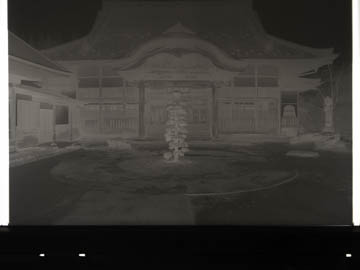Every Picture Is a Compromise
Lessons from the Also-rans
Most photography websites show the photographer's very best work. Wonderful. But that's not the full story of a creative life. If we want to learn, we'd better pay attention to the images that aren't "greatest hits" and see what lessons they have to offer. Every picture is a compromise — the sum of its parts, optical, technical, visual, emotional, and even cosmic – well, maybe not cosmic, but sometimes spiritual. Success on all fronts is rare. It's ok to learn from those that are not our best.
This is a series about my also-rans, some of which I've been able to improve at bit (i.e., "best effort"), none of which I would consider my best. With each there are lessons worth sharing, so I will.
Original digital captureFailures from Japan, 1990This week (mostly for my own amusement), I'll discuss images from a trip to rural northern Japan in 1990 with David Grant Best. Back in the film days — when things could really go wrong and you wouldn't know it until long after the trip was over. What I saw that I liked:Some of you youngsters will have no idea what that is above, but it's a scan of a "negative." Ask your grandfather. What I don't like in the picture:Every photographer has a story of catastrophic failure somewhere along the line. This is mine. During my trip to rural northern Japan in 1990 with my friend David Grant Best, I brought with me a fairly new modified Pentax 1° Spot Meter I had proudly purchased from Fred Picker a few months earlier. It was a great tool and I quickly fell into complete dependence upon it. Unfortunately, somewhere along the line I must have either dropped it or something, because during the first week of my work in Japan I didn't realize it was giving me meter readings that overexposed the film by about 6 stops. The negatives were all bullet-proof, which I didn't realize until I got home and developed the film. When film is overexposed by 6 stops, you are lucky to get the crappy results at left. This is one of the "better" images — but still completely unsalvageable. I suppose I could pass it off as a photograph from the early 19th century. What I learned:It was about day 8 of the trip when I was photographing outdoors on a sunny day that I realized my exposures should have conformed to the "Sunny 16 Rule." I was using Agfapan 100 film with I always shot at ASA 50. Therefore, my sunny exposures should have been f/16 at 1/50th of a second. Instead, my broken light meter was telling me to shoot at f/4 at 1/15th of a second — six full stops too much exposure. Huh? What? Really? Doubt finally broke through my unwarranted faith in the meter. I had a cheap Sekonic incident light meter with me as a back up and checked the Pentax against the Sekonic. Uh-oh. Live and learn. NEVER BLINDLY TRUST YOUR EQUIPMENT. Two seconds of thought would have shown me that the Pentax was malfuntioning. Instead, all I have from that first week of photography in Japan are ruined negatives and a few shots where I did use the Sunny 16 Rule and got good exposures. Thank goodness I had two more weeks of photography left to salvage the trip. |


